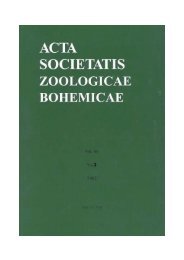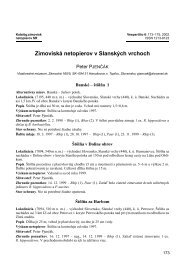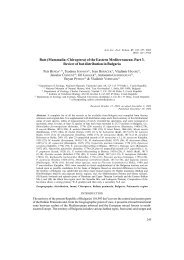Untitled
Untitled
Untitled
Create successful ePaper yourself
Turn your PDF publications into a flip-book with our unique Google optimized e-Paper software.
The recognition of terrestrial impact structures<br />
Shatter cones<br />
The only known diagnostic shock effect that is megascopic<br />
in scale is the occurrence of shatter cones (Dietz<br />
1968). Shatter cones are unusual, striated, and horse-tailed<br />
conical fractures ranging from millimeters to meters in<br />
length produced in rocks by the passage of a shock wave<br />
(e.g. Sagy et al. 2002). The striated surfaces of shatter<br />
cones are positive/negative features and the striations are<br />
directional, i.e., they appear to branch and radiate along<br />
the surface of the cone. The acute angle of this distinctive<br />
pattern points toward the apex of the cone and the shatter<br />
cones themselves generally point upward with their axes<br />
lying at any angle to the original bedding. Once the host<br />
rocks are graphically restored to their original impact position,<br />
shatter cones indicate the point of impact.<br />
Shatter cones are initiated most frequently in rocks that<br />
experienced moderately low shock pressures, 2–6 GPa<br />
(Fig. 5), but have been observed in rocks that experienced<br />
~25 GPa (Milton 1977). These conical striated fracture<br />
surfaces are best developed in fine-grained, structurally<br />
isotropic lithologies, such as carbonates and quartzites.<br />
They do occur in coarse-grained crystalline rocks but are<br />
less common and poorly developed. They are generally<br />
found as individual or composite groups of partial to complete<br />
cones (Fig. 10) in place in the rocks below the crater<br />
floor, especially in the central uplifts of complex impact<br />
structures, and rarely in isolated rock fragments in breccia<br />
units. Shatter cones are used as a diagnostic field criterion<br />
to identify impact structures (e.g. Dietz 1947, Milton<br />
1977).<br />
Conclusion<br />
The detailed study of impact events on Earth is a relatively<br />
recent addition to the spectrum of studies engaged in<br />
by the geological sciences. More than anything, it was<br />
preparations for and, ultimately, the results of the lunar<br />
and the planetary exploration program that provided the<br />
initial impetus and rationale for their study. Some recent<br />
discoveries have resulted from the occurrence or re-examination<br />
of unusual lithologies, rather than an obvious circular<br />
geological or topographic feature. For example,<br />
unusual breccias at Gardnos, Norway and Lockne, Sweden<br />
had been known for some time, but their shock-metamorphic<br />
effects were documented only recently, and they<br />
are now associated with the remnants of impact structures<br />
(French et al. 1997, Lindström and Sturkell 1992).<br />
The level of knowledge concerning individual terrestrial<br />
impact structures is highly variable. In some cases, it<br />
is limited to the original discovery publication. In terms of<br />
understanding the terrestrial record, this is compensated,<br />
to some degree, by the fact that impact structures with similar<br />
dimensions and target rocks have the same major characteristics.<br />
Nevertheless, there is still much to be learned<br />
about impact processes from terrestrial impact structures,<br />
Figure 10. Complete shatter cone in limestone, Cap de la Corneille,<br />
Charlevoix, Canada.<br />
particularly with respect to details of the third dimension.<br />
This is the property that is unobtainable from impact structures<br />
on other bodies in the solar system, where it must be<br />
studied by remote-sensing methodologies.<br />
Apart from increasing our understanding of impact<br />
processes, the study of terrestrial impact structures has influenced<br />
the siting of significant economic deposits<br />
(Grieve and Masaitis 1994, Donofrio 1997, Grieve 1997).<br />
In addition, the documentation of the terrestrial impact<br />
record provides a direct measure of the cratering rate on<br />
Earth and, thus, a constraint on the hazard that impact<br />
presents to human civilization (Gehrels 1994). The K/T<br />
impact may have resulted in the demise of the dinosaurs as<br />
the dominant land-life form and, thus, permitted the ascendancy<br />
of mammals and, ultimately, humans. It is, however,<br />
inevitable that human civilization, if it persists long<br />
enough, will be subjected to an impact-induced environmental<br />
crisis of potentially immense proportions.<br />
Acknowledgements. We would like to thank J. Ormö and<br />
A. Deutsch for their critical reviews. This paper is GSC contribution<br />
No. 2002141.<br />
References<br />
Ahrens T. J., Petersen C. F., Rosenberg J. T. (1969): Shock compression<br />
of feldspars. J. Geophys. Res. 74, 2727–2746.<br />
Ariskin A. A, Deutsch A., Ostermann M. (1999): The Sudbury “Igneous”<br />
Complex: simulating phase equilibria and in situ differentiation for<br />
two proposed parental magmas. In: Dressler B. O. and Sharpton V.<br />
L. (eds) Large Meteorite Impacts and Planetary Evolution II. Geol.<br />
Soc. Amer. Spec. Pap. 339, pp. 373–387.<br />
Ashworth J. R., Schneider H. (1985): Deformation and transformation in<br />
experimentally shock-loaded quartz. Phys. Chem. Miner. 11,<br />
241–249.<br />
Borg I. Y. (1972): Some shock effects in granodiorite to 270 kbar at the<br />
Piledriver site. In: Head H. C. et al. (eds) Flow and fracture of rock.<br />
Amer. Geophys. Union Monograph, Washington, D.C., pp. 293–311.<br />
Brenan R. L., Peterson B. L., Smith H. J. (1975): The origin of Red Wing<br />
Creek structure: McKenzie County, North Dakota. Wyoming Geol.<br />
Ass. Earth Sci. Bull. 8, 1–41.<br />
Bunch T. E. (1968): Some characteristics of selected minerals from<br />
craters. In: French B. M. and Short N. M. (eds) Shock Metamorphism<br />
of Natural Materials. Mono Book Corp., Baltimore, pp.<br />
413–432.<br />
261








